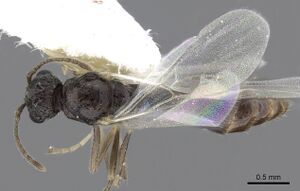Temnothorax adlerzi
| Temnothorax adlerzi | |
|---|---|

| |
| Conservation status | |
| Scientific classification | |
| Kingdom: | Animalia |
| Phylum: | Arthropoda |
| Class: | Insecta |
| Order: | Hymenoptera |
| Family: | Formicidae |
| Subfamily: | Myrmicinae |
| Tribe: | Crematogastrini |
| Genus: | Temnothorax |
| Species group: | corsicus |
| Species: | T. adlerzi |
| Binomial name | |
| Temnothorax adlerzi (Douwes, Jessen & Buschinger, 1988) | |
This is a workerless social parasite and only gynes have been found in nature, though in laboratory conditions a single worker is reported to have developed (Douwes et al, 1988). It is only known from Greece and is found in the nests of Temnothorax exilis (Báthori et al., 2024).
| At a Glance | • Workerless Inquiline |
Identification
Báthori et al. (2024) - Salient external morphological features help separating the gynes of T. adlerzi from every closely related species except Temnothorax ravouxi. These two species are very similar to each other. Morphometry yields an almost flawless separation for nest sample means (Fig 8), and a combination of five morphometric traits (D5a = +0.047*CW -0.073*FR -0.035*SPWI -0.018*ML +0.057*SPST +2.974) is necessary to separate individual gynes. This function yields a 94.5% classification success rate. The range of discriminant D5a scores for gynes are as follows:
- T. adlerzi gynes D5a (n = 17) = +1.699 [-0.160, +3.894]
- T. ravouxi gynes D5a (n = 110) = -1.699 [-4.064, +1.113]
Keys including this Species
Distribution
This species is known only from some parts of northern and southern Greece (Báthori et al., 2024).
Latitudinal Distribution Pattern
Latitudinal Range: 37.975° to 37.975°.
| North Temperate |
North Subtropical |
Tropical | South Subtropical |
South Temperate |
- Source: AntMaps
Distribution based on Regional Taxon Lists
Palaearctic Region: Greece (type locality).
Distribution based on AntMaps
Distribution based on AntWeb specimens
Check data from AntWeb
Countries Occupied
| Number of countries occupied by this species based on AntWiki Regional Taxon Lists. In general, fewer countries occupied indicates a narrower range, while more countries indicates a more widespread species. |

|
Estimated Abundance
| Relative abundance based on number of AntMaps records per species (this species within the purple bar). Fewer records (to the left) indicates a less abundant/encountered species while more records (to the right) indicates more abundant/encountered species. |

|
Biology
Castes
Images from AntWeb

| |
| Paratype of Epimyrma adlerzi. Queen (alate/dealate). Specimen code casent0901767. Photographer Ryan Perry, uploaded by California Academy of Sciences. | Owned by NHMUK, London, UK. |
     
| |
| Paratype of Epimyrma adlerzi. Male (alate). Specimen code casent0901768. Photographer Ryan Perry, uploaded by California Academy of Sciences. | Owned by NHMUK, London, UK. |
Nomenclature
The following information is derived from Barry Bolton's Online Catalogue of the Ants of the World.
- adlerzi. Epimyrma adlerzi Douwes, Jessen & Buschinger, 1988: 240, figs. 2-5 (q.m.) GREECE. Combination in Myrmoxenus: Schulz & Sanetra, 2002: 167; in Temnothorax: Ward et al., 2014: 15.
Description
Karyotype
- See additional details at the Ant Chromosome Database.
 Explore: Show all Karyotype data or Search these data. See also a list of all data tables or learn how data is managed.
Explore: Show all Karyotype data or Search these data. See also a list of all data tables or learn how data is managed.
- n = 10 (Greece) (Douwes et al., 1988) (as Epimyrma adlerzi).
References
- Báthori, F., Seifert, B., Heinze, J., Kiran, K., Karaman, C., Csősz, S. 2024. Taxonomy of the Palearctic socially parasitic Temnothorax (Myrmoxenus) ants (Hymenoptera: Formicidae). PLOS ONE, 19(10), e0308712 (doi:10.1371/journal.pone.0308712).
- Buschinger, A. 1989a. Evolution, speciation, and inbreeding in the parasitic ant genus Epimyrma (Hymenoptera, Formicidae). Journal of Evolutionary Biology 2: 265-283.
- Douwes, P.; Jessen, K.; Buschinger, A. 1988. Epimyrma adlerzi sp. n. (Hymenoptera: Formicidae) from Greece: morphology and life history. Entomol. Scand. 19: 239-249.
- Schulz, A.; Sanetra, M. 2002. Notes on the socially parasitic ants of Turkey and the synonymy of Epimyrma (Hymenoptera, Formicidae). Entomofauna 23(14): 157-172 (page 167, Combination in Myrmoxenus)
References based on Global Ant Biodiversity Informatics
- Borowiec L. 2014. Catalogue of ants of Europe, the Mediterranean Basin and adjacent regions (Hymenoptera: Formicidae). Genus (Wroclaw) 25(1-2): 1-340.
- Borowiec L., and S. Salata. 2012. Ants of Greece - Checklist, comments and new faunistic data (Hymenoptera: Formicidae). Genus 23(4): 461-563.
- Borowiec L., and S. Salata. 2017. Ants of the Peloponnese, Greece (Hymenoptera: Formicidae). Polish Journal of Entomology 86: 193-236.
- Czechowski W., A. Radchenko, W. Czechowska and K. Vepsäläinen. 2012. The ants of Poland with reference to the myrmecofauna of Europe. Fauna Poloniae 4. Warsaw: Natura Optima Dux Foundation, 1-496 pp
- Douwes, P., K. Jessen, and A. Buschinger. "Epimyrma adlerzi sp. n. (Hymenoptera: Formicidae) from Greece: morphology and life history." Entomologica Scandinavica 19 (1988): 239-249.
- Heinze J., A. Buschinger, T. Poettinger, M. Suefuji. 2015. Multiple convergent Origins of workerlessness and inbreeding in the socially parasitic ant genus Myrmoxenus. PLoS ONE 10(7): e0131023. doi:10.1371/journal.pone.0131023
- Pages using DynamicPageList3 parser function
- IUCN Red List vulnerable species
- Ant Associate
- Host of Temnothorax exilis
- Workerless Inquiline
- North temperate
- Karyotype
- Species
- Extant species
- Formicidae
- Myrmicinae
- Crematogastrini
- Temnothorax
- Temnothorax adlerzi
- Myrmicinae species
- Crematogastrini species
- Temnothorax species
- Need Overview
- Need Body Text
- IUCN Red List


